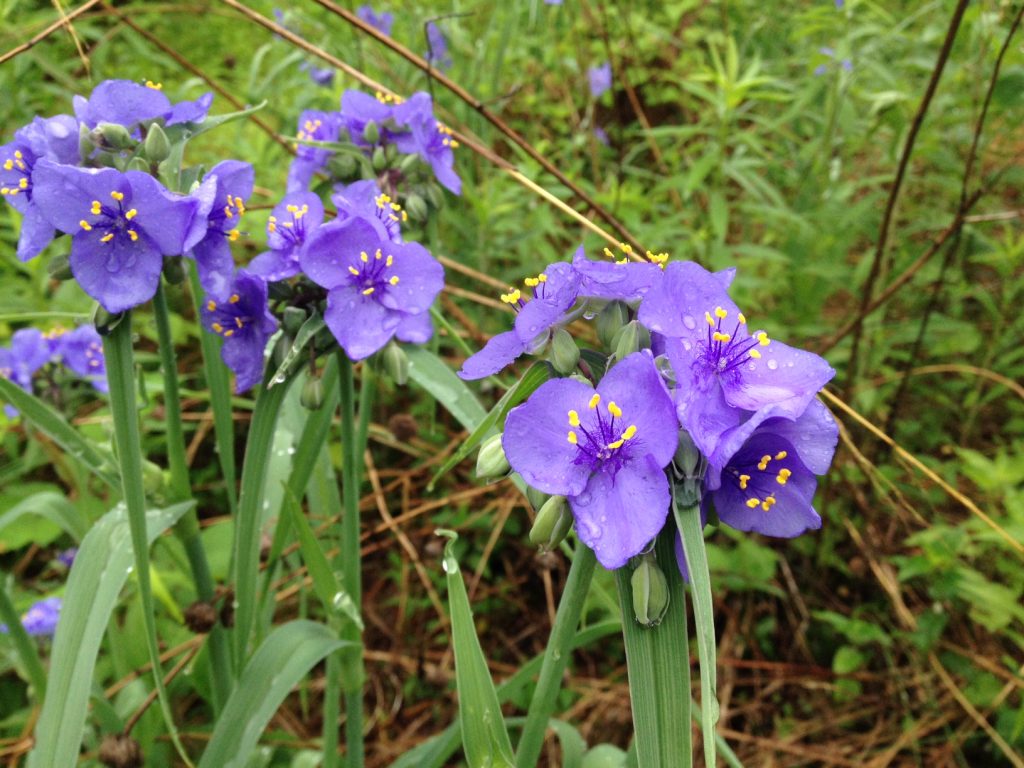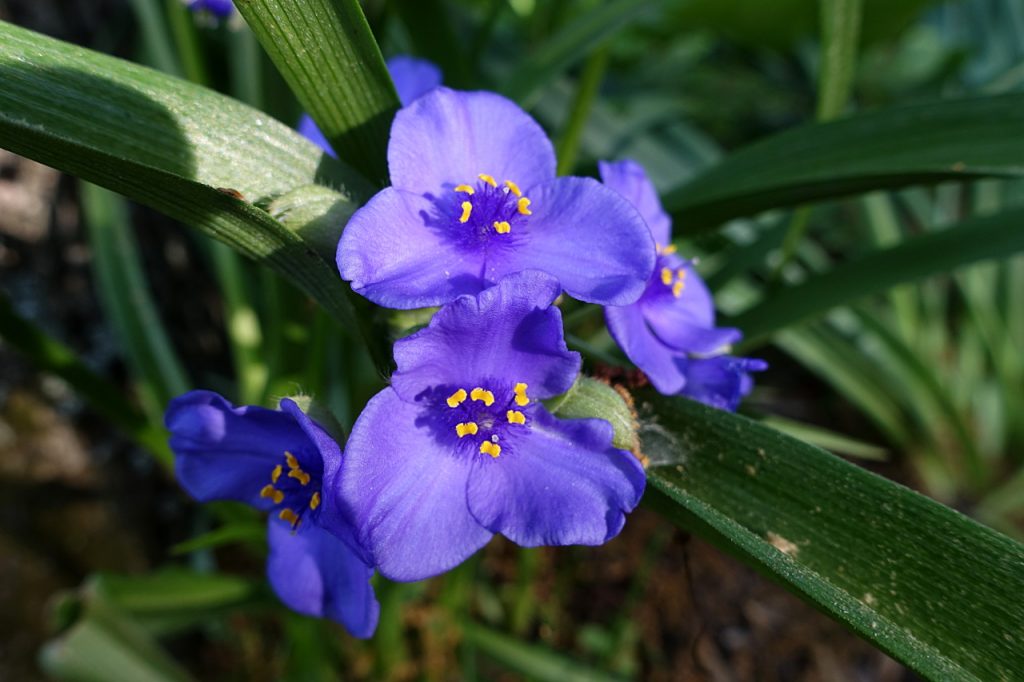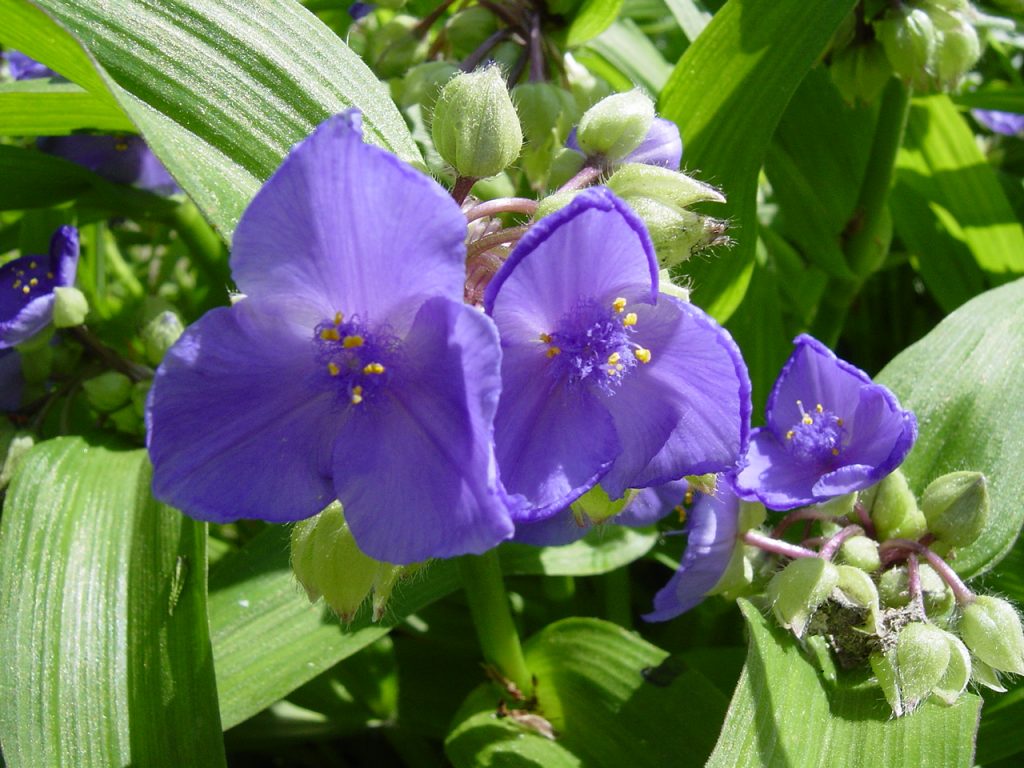Tradescantia Virginia - a beautiful flower
Europe learned about this flower back in the 18th century, with the beginning of the development of the American Wild West. For the first time Tradescantia was described by the father and son of Tradescant, botanists-travelers (the plant was named in their honor). And in Russia, exotic appeared in 1860 - then it was cultivated in the botanical garden of St. Petersburg. Now, in the 21st century, Virginia Tradescantia is very popular and adorns gardens and summer cottages throughout the country.

Tradescantia virginiana
Description of the flower
It is a perennial herb with erect, branched shoots, the maximum length of which is 60 cm. The shoot is covered with narrow green (monochromatic) leaves. Each sheet is up to 20 cm long.
Flowering is long, from mid-summer to autumn (lasts about 8 weeks), often until the very cold. All this time, umbellate inflorescences, consisting of small pink or purple flowers, open at the tips of the shoots (each lives only a day).
The flowers of street tradescantia do not smell. But pollinating insects are attracted by their bright colors.
The plant has many popular names: American grass, saxifrage, woman's gossip.
Purchase and adaptation
You can buy this garden flower in large retail outlets (where it is sold in transshipment containers).

Virginia Tradescantia
The plant does not need to be kept in such a container. Lifting the pot, you might wonder how light it is. The fact is that the seedlings sold for sale are planted in the so-called transport soil. It is not nutritious, but filled with the chemistry that makes the seedlings bloom beautifully in the store.
If you want your Tradescantia to be healthy, immediately transplant it to your site.
You can also buy seedlings from amateur gardeners. They offer mostly freshly dug cuttings.
- The advantage of such a purchase is that you can see the root system in all its glory, rejecting rotting specimens.
- The disadvantage is that if you forget to wrap the roots with a wet towel, they can dry out, and the plant will not take root well.
Planting and transplanting
You can plant Tradescantia in spring, summer and early autumn. But in the summer or autumn months, it is better to shorten the shoots before planting - this will allow the bush to save a little energy, putting all the resources into rooting.
When planting several bushes, leave 35 to 40 cm between them.
Before planting a flower, the soil should be fertilized and slightly fluffed. Dig up a flower bed with leafy soil (also called garden soil), humus, and sand.
It is important to choose not fine (construction), but coarse (river) sand. After taking in water, it will not "cement" the soil, but, on the contrary, will contribute to good drainage of the site.
In dry soil, planting should end with abundant watering.
Conditions of detention
Tradescantia is planted on alpine slides, mixborders, along the fence. In addition, she feels great on the banks of a natural or artificial reservoir and in other wet places.

Virginia Tradescantia photo
The neighbors of this flower can be astilbe, ferns, lungwort, heuchera and hosts.
This plant prefers humified, fertile, easily permeable soil. In terms of acidity, it should be neutral (with a pH of 6.6 to 7.5).
If indoor tradescantia like to be at a temperature of about 20 degrees all year round, then the garden one is a perennial that is not afraid of our winters. When preparing a plant for wintering, it must be abundantly mulched. In the northern regions, the flowerbed should be covered with non-woven material.
Lighting
Tradescantia is photophilous and will not mind if direct sunlight begins to fall on it. But in the shade, she, too, will not refuse to grow. But the shadow should be light (openwork partial shade). In dense shade, the shoots of the flower can stretch out.
It is important that the site is cozy - protected from wind gusts and drafts.
Humidity
Tradescantia loves wet places. It will bloom beautifully on the damp shore of the reservoir, next to bathing suits, daylilies and irises.
In addition, in such a place, the plant does not have to be constantly watered, due to which caring for the flower will be reduced only to plucking weeds and infrequently fluffing the soil.
Care
Fertilizers and feeding
For this ornamental crop, a universal fertilizer for flowers (the so-called general-purpose mineral water) is suitable - it is diluted according to the instructions and applied in two stages:

Tradescantia virginian planting and care
- from March to April (top dressing will help the plant "wake up" faster);
- in the middle of summer (when the budding period begins at Tradescantia - in this case, fertilizing can be applied until the end of flowering).
Mulching with compost will also be useful for the bush.
By the way! In order for flowers to appear more often, wilted buds need to be cut off in time - this will allow the plant to save energy on the ripening of seeds (you hardly need them, especially if your variety is a hybrid) and throw all resources into the formation of new buds.
Watering
Water-loving Tradescantia loves frequent and generous watering. The upper part of the soil should be allowed to dry out a little, but the ground in the depths and near the roots should be slightly damp even in hot summers.
By the way! If the season is rainy, watering can be avoided.
Is it possible to grow a flower in the country, that is, in a place where you do not always visit and cannot always water the flower bed on time? Yes, the succulent leaves of the plant will accumulate enough moisture to survive until your return (even if something detains you in the city), especially if the bush grows near the pond.
In winter, Tradescantia does not need irrigation. However, if you live in one of the southern regions and your flower beds do not hide under the snow, look at the situation. Sometimes a bush that does not "hibernate" needs rare and small doses of water.
Transfer
You can resettle the bush in spring and autumn. After the procedure, it is well watered.
What is this procedure for? Tradescantia growing for a long time in one place can give abundant self-seeding, growing in different directions. The transplant will help "tame" such a bush. And also - get rid of dry, ugly shoots.
Reproduction methods
Seeds
This method of reproduction is called generative.
You need to buy seeds no later than March.
Stages:
- A mixture of peat and sand is poured into bowls (disposable cups, tray).
- Seeds are spread over the surface, slightly pressing into the ground. You can help yourself with tweezers or a toothpick.
- The soil is sprayed, the bowls are tightened with sticky cling film or covered with a disposable bag / piece of transparent glass.
You need to keep the bowl on the western or eastern windowsill (so that the light is diffused), in a warm room, the temperature in which does not drop below 20 ° C.
From time to time, the greenhouse is opened slightly to wipe the condensate from the film and water the soil. When the seedlings appear (this should happen 1-2 weeks after sowing), you can get rid of the film.
Seedlings (sprouts with several true leaves) need to be dived into separate pots with garden soil fluffed with peat. And when they get stronger, they are planted in a flower bed.
If you live in a warm enough region, you can try sowing seeds outdoors. They do it in April.
Generative bushes will bloom for 2-3 years of life.
By the way! Growing Tradescantia by seed will give you the opportunity to choose varieties. The most successful is the "Precious Stones". And some manufacturers (for example, "Plasma Seeds") in one bag immediately offer a mixture of varieties blooming in different shades.
Cuttings
You can root the top of the stem, the length of which is from 10 to 15 cm. It is worth cutting it in the summer.

Tradescantia virginian precious
The easiest way is to remove the lower leaves, put the twig in a glass of water and wait for the roots to appear.
The cutting will grow faster in a mixture of street soil, sand and peat. In this case, the lower leaves are also removed, the stalk deepens by 1-2 nodes. The container with the handle should be packed in a transparent bag, kept in partial shade and moderate heat (20-15 degrees).
The roots should appear in 3 weeks. A plant in the ground will let you know about this by the appearance of new leaves.
A rooted and grown specimen can be planted in a flower bed, it will withstand wintering.
By dividing an adult plant
With a planned transplant, an old, thoroughly overgrown bush can be divided into several smaller bushes. But the cuttings should be large - small bushes turn out to be painful, taking root badly.
The roots of the mother plant must be shaken off from the soil, after which the root system is divided using a sharp blade. For insurance, all places of cuts should be immediately sprinkled with crushed coal (disinfection).
Important: the "operated" rhizome should not be allowed to dry out. Delenki are immediately planted in a flower bed. And if the plant is detached for sale, temporarily "attach" it to a carrier pot.
Diseases and pests
| Problem | Cause | Decision |
| Discoloration of leaves, elongated shoots. The bush may refuse to bloom (or bloom very poorly) | The bush grows in too thick shade. | We need light, but not a hot midday, but diffused |
| The stem is bare | The plant either lacks fertilizer or moisture | Set up watering |
| Brown (dry) leaf tips | The air around the flower is too dry. | If Tradescantia is planted near a reservoir, such a disease should not happen. But if it grows in the garden and the trees growing from above steal all the dew, watering the bush, spray it a little. |
| Root rot | The leaves, and then the stems, turn black. | Although Tradescantia is moisture-loving, if the flower grows in a solid puddle, its roots can begin to collapse. This is very bad - when the disease appears on the leaves, the roots will already be damaged too much. You can try to dig out the bush and separate all the rotten areas of the roots by replanting the remains of the plant in a drier place. |
| Blackleg | First, the lower part of the stem is covered with a slimy coating. Then the root section of the stem turns black and becomes thinner, breaking at the base. The reason is too high humidity. | The disease is considered fatal. The bush is doomed - have time to save the tradescantia growing nearby by transplanting them to a drier place and watering with a fungicide solution for prevention. |
| Sooty fungus | A dark film covering the outside of the leaves. Often appears after pests, since insects seriously undermine the plant's immunity. | First, remove the pests. Then wash the bush with soapy water, gently rubbing each leaf with a soft sponge. |
| Slugs | After the visit of the creeping pests, the leaves will be nibbled. However, the slugs themselves are also in no hurry to get away from the scene. | Poisons will not help against these "masters". Slugs need to be collected by hand (in villages, villains are thrown to poultry - they are especially fond of chickens).You can mulch the flower bed with something sharp (coniferous litter), make a trap (a hole in which to put a jar of beer). There is also a commercially available chemical against slugs, but experienced gardeners say that it does not work well. But good reviews are received by "natural barriers" from parsley, marigolds, and garlic growing nearby. |
| Aphid | Young leaves curl, and the newly grown shoots die off. Also, a sticky coating may be observed on the bush. | The bush should be sprayed with a solution of washing soap or a commercially available insecticide (say, Actellika). 2 weeks later, the treatment must be repeated, even if there are no traces of pests. |
| Shield | The leaves turn pale, fall off, becoming covered with brown small "plaques", hard to the touch. | Use insecticides. |
| Thrips | The leaves are covered with tiny brown dots and dry. If you come up with a magnifying glass in your hand, you can see small black dots on the wrong side of the sheets - these are the enemies. | If the infestation has just begun, spraying with soap will help. If you overlooked and the bush was badly damaged, buy an insecticide poison. |
| Pautonomic mite | The bush withers, the leaves turn pale, covered with a light cobweb. | If an insecticide (poison against plants) helps against other pests, you need to buy an acaricide (poison against ticks) against the tick. But there are also drugs "against all", general action. In any case, the treatment should be carried out 2, but better - 3 times with a weekly interval. |
m.
The good news is that most pests are afraid of humid air. So if your Tradescantia grows where it should be (near a pond or in a garden, regularly "bathing" in dew), you will not encounter them. This garden plant is also resistant to diseases.
Healing properties
Classical (scientific medicine) is not interested in this plant and practically does not study it.

Tradescantia virginian gemstones
But the traditional medicine of Latin America and Asia (including Buddhist monks) have long respected this flower. The leaves are applied to fresh wounds or boils, and in Cuba they are used as an aid for gastritis and gastrointestinal infections.
The official medicine of some South American countries also began to look closely at the flower. In particular, Jonathan Pirrero (a biologist from Venezuela) stated that he had found a substance similar to insulin in the plant. That is, Tradescantia juice can lower a person's blood sugar levels.
However, it is impossible to recommend taking homemade tinctures, rubbing and other homemade medicines from Virginia Tradescantia. The plant has not been studied, so our doctors do not know how toxic it is and whether it is an allergen.

